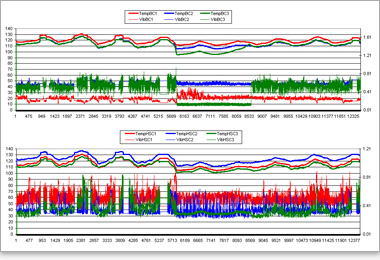Actively predict malfunction and know exactly when to service or replace components
Motors, Chain drives, Conveyor belt drives – all use bearings. Expensive ones. When they break – it’s bad. Down time, lost man hours, costly repairs & long delays are only a small sample of the results of a single malfunction.
Every bearing has a signature – a certain way it oscillates when it turns, a unique frequency. If you can listen to this sound – you can tell if it’s running like a top, or about to come to a screeching halt.
A vibration sensor placed in proximity to the bearing is able to gather data constantly and send it to the TRAKKER system. The system analyzes the data, sends you notifications if that “signature” ever changes – which would indicate that something was wrong. In the case of a chipped bearing – you would have only 3 days before complete failure.
Keep your Motors working right
The TRAKKER has the ability to monitor any motor with the following measurements:
Bearing vibration
The signature from the Accellerometer sensor placed on a bearing's housing can be easily installed on Motors, Chain drives, Belt drives, Gear reducers, Conveying systemsTemperature
Higher temp indicates worn internal parts and can result in significantly decreased life span. The rule of thumb is for every 100°C (180°F) of additional heat in the windings, the insulation life is cut by half. It will also cause deterioration in most lubricants, seals and bearings.Power Consumption (amp draw) via the current transformers (CT's)
If a motor is operating efficiently, the amount of power it uses will be consistent with other motors in similar installations and level of wear. The system will determine the precise time when internal parts are causing the motor to take more energy out of the system than it is worth to repair or replace a part.Noise level (dB)
Slight changes in noise levels that might otherwise go unnoticed can indicate changes inside the housing like wear or misalignment.
How TRAKKER reads the data
For example, if the current draw and temperature readings were higher than normal, then the problem could be that the motor assembly is under-lubricated. In this case you would have 3 weeks to correct the problem before failure occurs. If the vibration sensor indicated that there was a problem with a bearing such as a chip, then there would be around 3 days before the motor would burn up or sieze. The system utilizes a constant reading that enables the problem to be fixed before it becomes a potential disaster.

- Trakker Vibration Analysis Sensors
Read about the various TRAKKER vibration sensors and the technical specifications of each one.
Vibration Analysis Resources
- A New Generation of Condition Monitoring
and Diagnostic SystemsA detailed look at continuous monitoring of rotating machinery via installed vibration sensors. This contains information regarding diagnostics, calibration and condition monitoring. Also presents methods of determining how software can analyze sensor data charts to make decisions.
 Field Analysis and Balancing Tools
Field Analysis and Balancing ToolsA detailed article that outlines machine condition monitoring as a field technician would go about it. It examines the elements of using handheld instruments through the process steps of detection, analysis, and correction (action steps) in machinery component vibration.
- The Principles of Piezoelectric Accelerometers
An overview of the internal workings of piezoelectric sensors (vibration sensors) that goes through the physical design and how various mathematical formulas calculate vibration and turn it into usable data. Also explains the differences between and typical applications of both low-impedance and high-impedance sensors.
